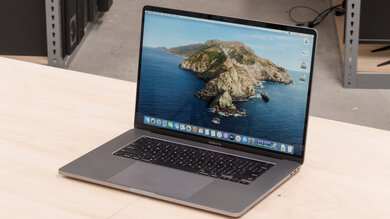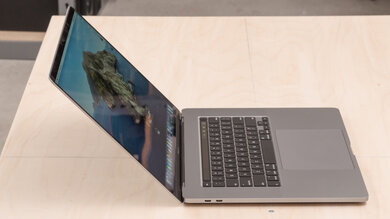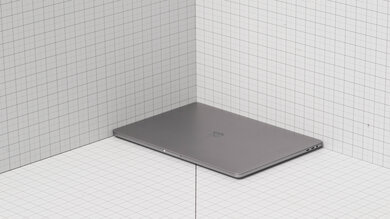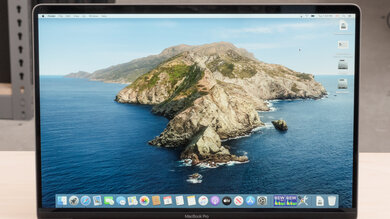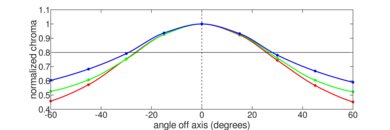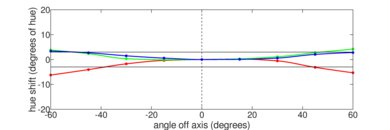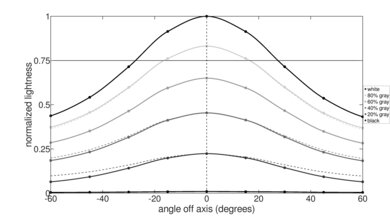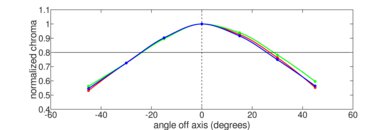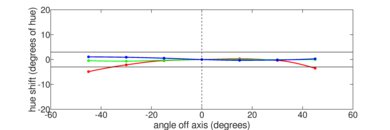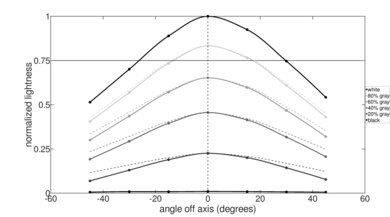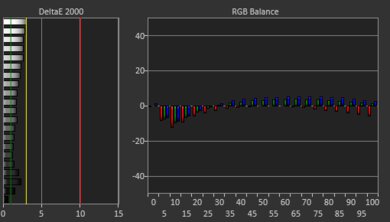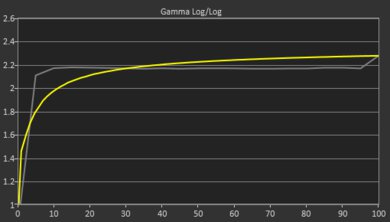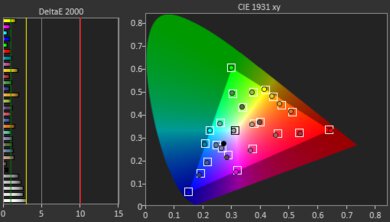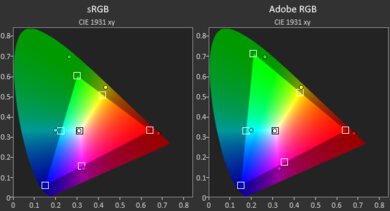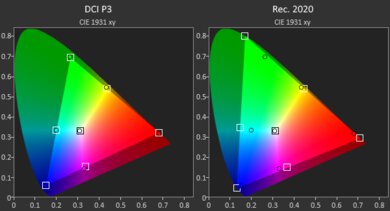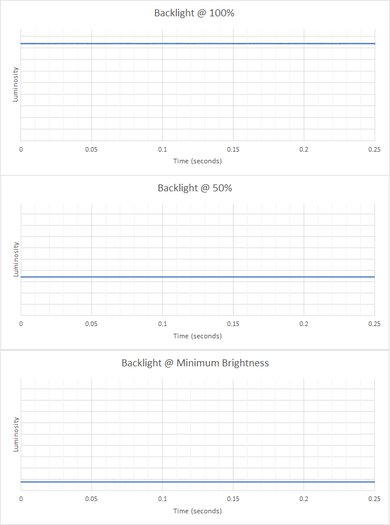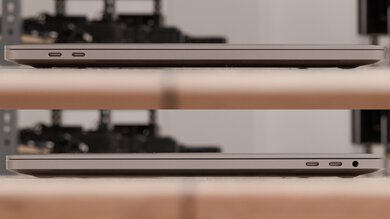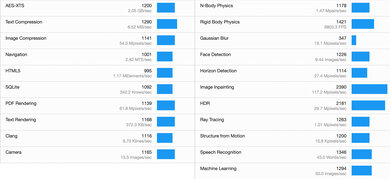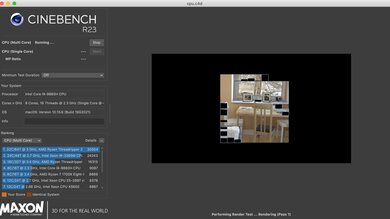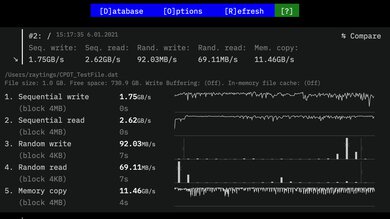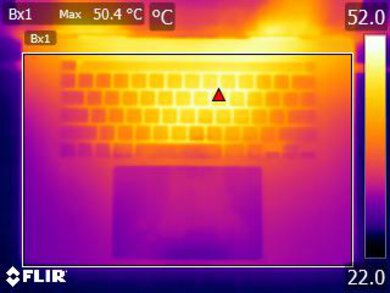The Apple MacBook Pro 16 (2019) is a laptop available with Intel 9th Gen CPUs, and AMD Radeon Pro dedicated graphics. It has a full aluminum body that feels exceptionally well-built, and it's relatively thin despite having a dedicated GPU, which is great for portability. It has a 16-inch high-resolution screen with full sRGB and DCI P3 coverage, a superb touchpad, and excellent speakers that get very loud. Like its predecessor, the MacBook Pro 15 (2019), it has a Touch Bar that lets you access settings and program-specific functions. There's also a fingerprint sensor to make it easier to log in and make purchases. Our configuration can handle demanding tasks with no performance loss over time, but it gets hot and noisy under load.
We tested the Apple MacBook Pro 16 with an Intel Core i9-9880H and an AMD Radeon Pro 5500M with 4GB of VRAM. The i7-9750H is the base CPU option and powerful enough to handle light to relatively heavy workloads. If you need better multi-threaded performance, we recommend going with the i9-9880H or the i9-9980HK because they have two additional cores. Likewise, the AMD Radeon Pro 5500M 4GB in our unit has adequate performance, but the GPUs with 8GB of memory will provide a smoother experience with fewer stutters or hangs, especially when working with high-resolution material or VRAM-intensive applications. For those who need as much graphical performance as possible, the AMD Radeon Pro 5600M with 8GB HBM2 memory is the top GPU option, providing a significant performance boost over the AMD Radeon Pro 5500M 8GB.
Our Verdict
The Apple MacBook Pro 16 laptop is very good for students. It feels exceptionally well-built, and it's easy to carry around as it's fairly thin. The battery lasts all day as long as you don't perform any CPU or GPU-intensive tasks. Its high-resolution screen provides plenty of space for split-screen multitasking and displays sharp images and text. The keyboard is okay, but some people may find it tiring to type on for a long time. It can handle most student workloads, including demanding tasks like 3D graphic design and physics simulations.
- Easy to carry around.
- Exceptional build quality.
- Webcam video looks natural with minimal artifacts.
- Large and responsive touchpad.
- Battery lasts through a typical 8-hour day for light productivity.
- Keyboard has very short travel and may be tiring to type on for some.
- 720p webcam.
The Apple MacBook Pro 16 inch laptop is mediocre for gaming. All CPU options are well-suited for gaming, but the GPUs might struggle to maintain a playable frame rate in demanding AAA titles, which means you'll have to lower the resolution or the graphical settings. Also, the screen is limited to a 60Hz refresh rate and doesn't support any variable refresh rate technology. There's no loss in performance over time when under a full load, but it gets very hot, and the fans are loud.
- Core i9 CPU can handle most single and multi-treaded workloads.
- Has dedicated GPU for demanding workloads.
- Fast SSD storage makes system feel snappy.
- 60Hz refresh rate and no VRR.
- Gets hot and loud under load.
- No user-replaceable parts.
The Apple MacBook Pro 16 inch laptop is very good for media consumption. It has excellent speakers that get very loud and a large, high-resolution screen that delivers a sharp image. It handles reflections well and gets more than bright enough to combat glare in well-lit settings. It's a fairly thin device that should fit into most bags, so it's easy to carry around. Battery life is great, enough to get you through a couple of movies and TV shows. Unfortunately, even though it has a good contrast ratio for an IPS panel, blacks still look grayish when viewed in the dark.
- Easy to carry around.
- High-resolution screen.
- Excellent speakers that get very loud.
- Exceptional out-of-the-box color accuracy.
- Great battery life for video playback.
- Blacks look grayish in the dark.
- No touch input.
The Apple MacBook Pro 16 laptop is good as a workstation. Our unit has an Intel Core i9-9880H that can handle demanding tasks and a dedicated GPU that can make hardware-accelerated applications feel smoother, like photo and video editing programs. It also has a very fast storage drive that you can configure up to 8TB. The laptop gets very hot and loud under load, but there's no performance loss over time. Unfortunately, you'll likely need a dongle or dock to connect to an external monitor because it only has USB-C ports.
- Core i9 CPU can handle most single and multi-treaded workloads.
- Has dedicated GPU for demanding workloads.
- High-resolution screen.
- Fast SSD storage makes system feel snappy.
- Gets hot and loud under load.
- No user-replaceable parts.
- Only USB-C ports.
The Apple MacBook Pro 16 laptop is good for business use. It feels well-built and is portable, and its battery lasts easily through a typical 8-hour day, which is great for those who travel a lot for work. However, you'll likely need to carry dongles because it only has USB-C ports. The keyboard is okay but can be tiring to type on over a long period. Serviceability is terrible because everything is soldered on, making it impossible to upgrade after purchase and hard to repair.
- Easy to carry around.
- Exceptional build quality.
- Webcam video looks natural with minimal artifacts.
- Core i9 CPU can handle most single and multi-treaded workloads.
- Large and responsive touchpad.
- Battery lasts through a typical 8-hour day for light productivity.
- Keyboard has very short travel and may be tiring to type on for some.
- No user-replaceable parts.
- Only USB-C ports.
- 720p webcam.
Differences Between Sizes And Variants
We tested the MacBook Pro 16 (2019) with an Intel Core i9-9880H, an AMD Radeon 5500M dedicated GPU with 4GB GDDR6 VRAM, 16GB of RAM, and 1TB of storage. The CPU, GPU, memory, and storage are configurable; you can see the available options in the table below. Apple's website lets you upgrade from the i7-9750H to the i9-9980HK while still keeping the AMD Radeon Pro 5300M and 512GB storage options, but not the i9-9880H. This means that the i9-9880H option starts with an AMD Radeon Pro 5500M with 4GB of VRAM and 1TB of storage.
| CPU |
|
|---|---|
| GPU |
|
| Memory |
|
| Storage |
|
| Color |
|
Our display and performance results are only valid for the configuration that we tested. If you come across a different configuration option not listed above, or you have a similar MacBook Pro 16 inch laptop that doesn't correspond to our review, let us know, and we'll update it. Some tests, like black uniformity and color accuracy, may vary between individual units.
You can see our unit's label here.
Compared To Other Laptops
The Apple MacBook Pro 14 (2021) is much better than the Apple MacBook Pro 16 (2019). The MacBook Pro 14 has a much better Mini LED display with ProMotion support, its keyboard feels more comfortable to type on for extended periods, and its webcam captures a more detailed image for video calls. The MacBook Pro 14 also has a wider port selection that includes a full-size HDMI and USB-C ports with Thunderbolt 4 support. The MacBook Pro 14's M1 Pro and M1 Max SoCs perform much better than the MacBook Pro 16's Intel CPU and AMD Radeon GPU, and they're more power-efficient, which leads to longer battery life.
The Apple MacBook Pro 16 (M3, 2023) is a newer version of the Apple MacBook Pro 16 (2019). The M3 version is significantly better in almost every way; it has a newer design with thinner bezels, a higher-quality 120Hz Mini LED display, a wider port selection, and most importantly, it uses Apple's ARM-based M3 Pro/Max SoCs instead of Intel x86 processors. The latter change brings considerably more processing power and better efficiency, leading to much longer battery life. Another change (like it or not) is the removal of the controversial TouchBar. A downside of this move to an ARM-based SoC is the removal of BootCamp, so if you need to use Windows for a specific task, you'll have to use a service like Parallels.
The Apple MacBook Pro 16 (2021) is much better than its predecessor, the Apple MacBook Pro 16 (2019). The 2021 model features Apple's ARM-based M1 Pro and M1 Max SoCs, which are significantly more powerful than the Intel 9th Gen Core CPUs on the 2019 model. The M1's integrated graphics perform better than the dedicated GPUs available on the older model. The M1 MacBook Pro's display is much better as it has a Mini LED backlight that provides local dimming and gets a lot brighter in HDR. The M1 MacBook Pro's keyboard feels better to type on, its webcam's video quality is better, and its wider port selection includes a full-size HDMI port and SD card reader. Last but not least, the M1 MacBook has significantly longer battery life, lasting five hours more than the 2019 model for light productivity.
The Apple MacBook Air 13 (M1, 2020) and the Apple MacBook Pro 16 (2019) are both productivity-focused laptops with many similarities. The most notable difference is that the MacBook Pro 16 uses an x86 Intel 9th Gen CPU with AMD Radeon Pro graphics, while the MacBook Air uses Apple's ARM-based M1 SoC, though it can still run x86 programs through Rosetta 2. The MacBook Pro is a better choice for creative professionals because its discrete GPU performs much better for graphically demanding tasks than the M1's integrated graphics. Also, it doesn't suffer any performance loss over time, whereas the MacBook Air throttles because it's a fanless device. As for the CPU performance, the MacBook Air's M1 chip is better in most instances, and it's significantly more power-efficient, resulting in much longer battery life.
Test Results

The Apple MacBook Pro 16 2019 has a simple design with a premium build. It has thin bezels, a large touchpad, and upward-firing speakers on both sides of the keyboard. Like the previous Apple MacBook Pro 15 (2019), it has a Touch Bar instead of the typical function keys at the top row of the keyboard.
The Apple MacBook Pro 16 inch laptop's portability is good. It's on the larger side for laptops, but the laptop as a whole is thin, especially for a model with a dedicated GPU. The charger isn't too big and should fit into most laptop bags. If you want a more compact MacBook, check out the newer Apple MacBook Pro 14 (2021).
The Apple MacBook Pro 16 laptop's serviceability is terrible. It's very hard to get into the laptop, as it requires a special P5 pentalobe screw bit to remove the screws and a prying tool like a guitar pick to pry it open. Also, the bottom pops out aggressively and may be dangerous as it's just a thin sheet of metal. There's no way to upgrade the components as everything is soldered on, so you need to get the configuration that best suits your needs when purchasing it. Opening the laptop or making changes to the hardware may void the manufacturer's warranty.
The Apple MacBook Pro 16 inch laptop has a large, high-resolution screen that displays sharp images and text. Its 16:10 aspect ratio provides more vertical space than a standard 16:9 display, which means you don't have to scroll as much.
The Apple MacBook Pro 16 2019 doesn't support any variable refresh rate technology, typical for a productivity-focused laptop. As you can tell from the amount of ghosting in the motion blur photo, the response time is slow, so it isn't ideal for viewing fast-moving content or gaming.
The Apple MacBook Pro 16 laptop's screen brightness is excellent. It's more than enough to provide good visibility, even in bright, sunny rooms. It also gets very dim at the lowest brightness setting, providing a more comfortable viewing experience in the dark.
The Apple MacBook Pro 16 inch laptop's horizontal viewing angles are okay. Colors fade fairly quickly when moving off-center. It's fine for sharing the screen with someone else as long as you don't mind a slightly inaccurate image.
The Apple MacBook Pro 16 inch laptop's vertical viewing angles are okay. Again, colors look washed out when viewing from above or below, so you need to look at the screen almost straight on to get the most accurate image.
The Apple MacBook Pro 16 laptop's out-of-the-box color accuracy is outstanding. Most color inaccuracies aren't noticeable, and the white balance is only slightly off. The color temperature is on the cooler side of our 6500K target, resulting in a very slight bluish tint. The gamma isn't bad, but most scenes are too bright, and dark scenes are too dark. Color accuracy can vary between individual units.
The Apple MacBook Pro 16 inch laptop has an exceptional color gamut. It has full sRGB and DCI P3 coverage, the color spaces used in most web and HDR content, respectively. Its Adobe RGB coverage is outstanding; it just has some trouble displaying very bright greens and blues. Its coverage of the wider Rec. 2020 is good, but again, it can't display very bright greens and blues.
The Apple MacBook Pro 16 2019 has a backlit keyboard with scissor switches instead of the butterfly switches used on the MacBook Pro 15 (2019). The keycaps feel high-quality and stable, but the key travel is very short, so it's easy to bottom out, making it somewhat tiring to type on for extended periods. Key spacing is okay, and the layout is similar to most Apple MacBook keyboards. It isn't loud and shouldn't bother people around you in a quiet environment. There's still a Touch Bar at the top row, but unlike the Pro 15, there's now a physical Escape button.
The Apple MacBook Pro 16 laptop's touchpad is superb. It's big enough to use gestures comfortably, and the glass surface feels very smooth. Unlike most touchpads, it uses haptic feedback to simulate the clicks, which means you can click anywhere on the touchpad, making it much easier to drag windows or files around. It supports Force Touch, meaning it can sense the amount of pressure applied. A harder press performs a different function or brings up a second contextual menu in some applications.
The Apple MacBook Pro 16 laptop's speakers are excellent. They get very loud with minimal compression at max volume. They're treble-heavy due to the lack of bass, but this is typical for most laptop speakers.
The Apple MacBook Pro 16 laptop's webcam captures a fairly clean image with minimal artifacts and natural-looking colors, but it's still limited to 720p, which might be disappointing for some. The microphone sounds clear, although there's some static here and there.
The Apple MacBook Pro 16 laptop's port selection is okay. All four USB-C inputs support charging, DisplayPort, Thunderbolt 3 (up to 40Gbps), and USB 3.2 Gen 2 (up to 10Gbps). There should be enough ports for most people, but you'll need a dongle or dock for peripherals that still have a USB-A connector or for memory cards. If you need a MacBook with more ports, check out the Apple MacBook Pro 16 (2021).
Unfortunately, the Apple MacBook Pro 16 inch laptop doesn't support Wi-Fi 6. If you need Wi-Fi 6, it's only available on the M1 Macs or newer, like the Apple MacBook Air 13 (M1, Late 2020).
The Apple MacBook Pro 16 laptop's CPU is configurable. There are three options: the Intel Core i7-9750H, the i9-9880H, and the i9-9980HK. Compared to the i9-9880H in our unit, the i7-9750H doesn't perform as well in multi-threaded applications because it has two fewer cores. However, the i7-9750H is powerful enough for light productivity tasks, like word formatting or checking emails. It can even handle demanding tasks if you don't have too many things running at once. The higher-end i9-9980HK has the same number of cores and threads as the i9-9880H, but it's a bit faster because it has slightly higher clock speeds. We recommend those running heavily multi-threaded applications to go with the i9 CPUs as they'll provide the smoothest experience.
All three options are high-end mobile CPUs, but they're already two generations old at the time of writing because they were introduced in 2019. Also, Apple has since released a new MacBook Pro 16 (2021) with their in-house M1 Pro and M1 Max SoCs.
We tested the AMD Radeon Pro 5500M with 4GB of VRAM, but there are three other options to choose from. We expect the lower-end AMD Radeon Pro 5300M to perform a little worse than the 5500M 4GB in our model because it has fewer compute units. Upgrading to the AMD Radeon Pro 5500M 8GB gives you more VRAM, which provides a smoother experience when working in memory-intensive applications or with high-resolution material. If you want the best GPU performance available on this laptop, we recommend going with the AMD Radeon Pro 5600M with 8GB HBM2 memory because it has the most compute units and higher memory bandwidth.
Apple seems to let you pair the i7-9750H and the i9-9980HK with the AMD Radeon Pro 5300M, but not the i9-9880H, so the i9-9880H starts with the AMD Radeon Pro 5500M with 4GB of VRAM. The Intel Core processors have integrated UHD Graphics 630; the system automatically switches between the integrated and dedicated graphics depending on the workload.
You can configure the Apple MacBook Pro 16 inch laptop with 16, 32, or 64GB of DDR4 memory. 16GB should be enough for most office tasks, but creative professionals might opt for more. Unfortunately, the RAM is soldered on, so you can't upgrade it after purchase.
The Apple MacBook Pro 16 inch laptop starts with 512GB SSD as the base configuration, except for the i9-9880H model, which starts with 1TB. You can get up to 8TB of storage on all models.
The Intel Core i9-9880H in our Apple MacBook Pro 16 inch laptop has an excellent score in the Geekbench 5 benchmarks. It has no problem performing simple tasks, and it can also handle heavy workloads quickly, like video encoding. The i7-9750H is similar to the i9-9880H in single-threaded workloads, but it falls behind in applications that can benefit from a higher core count. We expect the i9-9980HK to perform better than the i9-9880H, but not by much.
The AMD Radeon Pro 5500M 4GB's compute score is okay. It falls towards the lower-end of dedicated GPUs, but it's much better than integrated graphics and a decent step up from the base Radeon Pro 5300M option. The Radeon Pro 5600M is significantly faster and provides the best experience.
The Apple MacBook Pro 16 laptop's Blender score is good. Although we can't run the GPU benchmark on macOS, we expect all GPU options to perform better than the CPU in 3D rendering. The choice of the GPU depends on your workload and how fast you want to complete the rendering task. The GPU rendering time on Windows through Boot Camp is 3.2 min.
The AMD Radeon Pro 5500M 4GB in our unit performs okay in the Basemark GPU test. It's powerful enough to handle games from the App store and can likely maintain playable frame rates in more demanding modern titles. However, you'll have to turn down some graphics settings or play on Windows through Boot Camp to get good frame rates. The 8GB version of the Radeon Pro 5500M performs similarly to the 4GB model in our review unit, as having more VRAM only matters if you play at a higher resolution or graphical settings with more textures. While the AMD Radeon Pro 5600M can maintain much higher frame rates, for most games, you'll still have to play on Windows through Boot Camp to get the best experience. If you want a native Windows laptop with better GPU performance, check out the Dell Alienware m15 R3 (2020).
The Apple MacBook Pro 16 laptop has exceptional storage drive performance, resulting in great system responsiveness and fast file transfers. The speed of the SSD may vary depending on the size, as larger SSDs tend to perform better.
The Apple MacBook Pro 16 laptop has a massive battery. You can easily get through a typical 8-hour workday on a full charge if you're only doing light productivity, but it'll be slightly shorter if you play a lot of videos. Unfortunately, performing any tasks that engage the dedicated GPU is going to drain the battery quickly. The 100Wh battery is the maximum capacity allowed on most flights without special approval. Battery life varies greatly depending on your usage.
Our Apple MacBook Pro 16 laptop with an AMD Radeon Pro 5500M 4GB can't sustain playable frame rates in Borderlands 3 on the 'High' settings in 1080p. It's barely playable even at the lowest graphics settings. That said, it does perform much better when running the game on Windows through Boot Camp; you can see the results here. This game is mostly GPU-limited, so getting a more powerful GPU will result in a much better experience.
Civilization VI doesn't run very well on the 'High' settings at 1080p. There are a lot of micro-stutters, but it's still playable because Civilization VI is a real-time strategy game that doesn't require fast reaction time. The game runs better on Windows through Boot Camp, as running the game on macOS affects the turn time as well.
The Apple MacBook Pro 16 laptop achieves high frame rates in CS:GO, but it stutters a lot, making the game freeze for a few seconds at a time. We can't record the 1% and 0.1% lows because the program we use isn't compatible with macOS. CS:GO is an older title that every CPU and GPU configuration of the MacBook Pro can handle easily, but you have to run the game on Windows through Boot Camp to get the best experience.
Shadow of the Tomb Raider is a fairly demanding title and doesn't run particularly well on the 'High' settings in 1080p. It can't quite reach 60fps, and frequent frame drops cause noticeable stutters. Unfortunately, it doesn't run significantly better on Windows through Boot Camp. As this is a GPU-limited title, the AMD Radeon Pro 5600M will provide a much better experience and get you to a more stable 60fps with minimal tweaks in the settings.
The Apple MacBook Pro 16 laptop's thermal and noise performance is mediocre. When idle, the keyboard temperature is fairly cool, and there's almost no fan noise. However, the area around the letter 'i' gets very hot under load, and the fans get very loud, producing both a medium and high-pitched whining sound. If you prefer a laptop that makes less noise, check out the fanless Apple MacBook Air 13 (M1, Late 2020).
The Apple MacBook Pro 16 inch laptop's performance over time is superb. The CPU gets very hot at full load, but there's no measurable loss in performance over time. The GPU's temperature is quite good, and there's no performance loss over time either. We expect all configurations to perform similarly.
The Apple MacBook Pro 16 inch laptop doesn't include any special software other than what normally comes with macOS. If you prefer a Windows workstation, check out the Dell Precision 5560 (2021).
The Apple MacBook Pro 16 laptop has a fingerprint sensor built into the power button, making it easier and faster to log in. There's also a Touch Bar instead of the typical function keys, which you can use to adjust some settings, like brightness and volume, and access app-specific functions, like in Final Cut.

